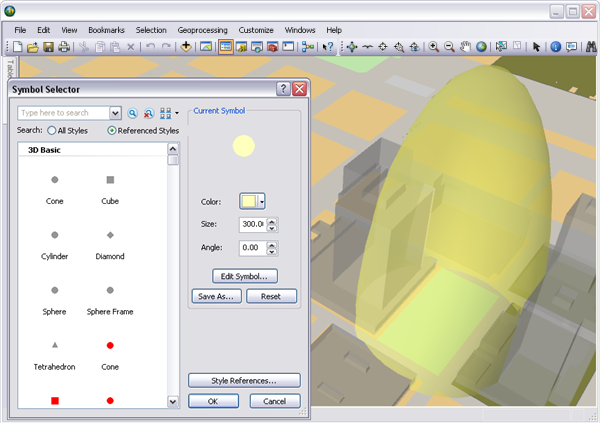Available with 3D Analyst license.
Overview
In 2007 a 24-inch underground steam pipe in a busy intersection of midtown Manhattan, New York, exploded. It created a 40-story-high shower of mud and flying debris and a towering cloud of steam higher than the Chrysler Building. The pipe was potentially wrapped in asbestos, a known carcinogen, so the site was declared an "asbestos containment area." The blast could have cracked windows and window seals, allowing contamination to enter buildings. The question that emerged was which buildings in the area would need to be sampled based on a set distance from the blast. The Intersect 3Dset operator geoprocessing tool can be used to answer this question.
This guidebook uses ArcScene to demonstrate how to use 3D set operator geoprocessing tools to prepare data for, and conduct analysis of, the threat represented by the contaminants from a steam pipe explosion. You will create multipatch features representing each building and intersect them with the threat zone. The same workflow will also apply to ArcGlobe.
3D set operators and closed multipatches
To use the Intersect 3D geoprocessing tool effectively, your input features must be closed multipatches. A closed multipatch is a collection of triangles and rings that defines a single volume of space. To be considered closed, the shell of the volume must have no gaps between triangles or rings. In addition, no triangles or rings that participate in defining the volume may overlap or intersect. If your buildings were created by converting extruded building footprints to multipatch features using the Layer 3D To Feature Class geoprocessing tool, your features are already closed.
If your buildings were created by converting complex sets of extruded polygons, many polygons per building, grouped into multipatch features, they are not closed. Each building has intersecting triangles where the source polygons overlapped and overlapping triangles where the polygons were adjacent. Use the Union 3D tool to combine all the triangles, intersect them, and dissolve out the extraneous features contained within the interior of the building to create closed multipatch features.

Create a threat zone for the steam pipe explosion
Next you will need to generate a threat zone that represents the area affected by the steam pipe explosion. Create a point feature class, add it to ArcGlobe or ArcScene, then use the 3D Editor toolbar to add a point at the location of the blast. Open the Layer Properties dialog box for that layer, click the Symbology tab, then change the point symbology to a simple marker symbol. Use the sphere symbol to represent the blast, and set the size of the sphere equal to the affected zone. To set transparency, click the Display tab on the Layer Properties dialog box or use the 3D Effects toolbar and set the percentage interactively.

To adjust size, use the Symbol Property Editor dialog box and change the individual x-, y-, and z-values of your symbol. In this case, set the width to 100, the depth to 100, and the size to 300. The result is a prolate spheroid representing the volume of space affected by the blast.

To finish defining the threat zone, convert this feature to a multipatch using the Layer 3D To Feature Class geoprocessing tool. The resulting multipatch is already closed, so no additional work is needed before intersecting the blast zone with surrounding buildings.

Intersecting multipatch features
Now you are ready to use the Intersect 3D geoprocessing tool to create an intersection between the buildings and the threat zone for the steam pipe explosion. Symbolize the intersection in a different color to highlight which portion of the buildings' surfaces will need to be sampled for contamination.

If you have the appropriate data, you can also use the result of the new intersection geometry to select building interior features, such as rooms. This will quickly give you a list of locations to check for breached windows for possible contamination.
This field guide demonstrated how you can use 3D set operator geoprocessing tools to assess which portions of a building's surface need to be sampled for contaminants as a result of a steam pipe explosion.